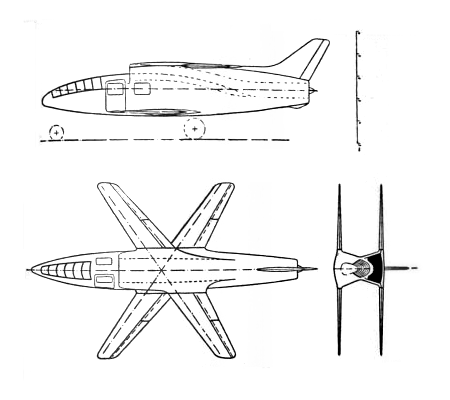- Joined
- 25 June 2009
- Messages
- 13,771
- Reaction score
- 3,042
Project of messenger-airplane in Yawing-Wing design for 1 pilot and 4 passengers (of 1944).
« The designers of high speed conventional airplanes, which are usually low- or mid-wing arrangements, prefer to place the tail controls as high as possible to keep the unavoidable wing-fuselage interference as low as possible. It is admitted that the designers of normal (conventional) airplanes have sought and found ways and means to reduce drag. The first of these is the forward swept wings which not only offer the advantage of lower drag but also prevent premature compression shocks. It was also found that rectangular wings of small aspect ratio have a similar effect.
Already during the war the behavior and utility of the yawing wing of lower drag has been under study. Its application however necessitates the return to the biplane if force-equilibrium about the vertical axis is attained.
In this arrangement stability may be had without tail structure due to the lift center lines located laterally to the longitudinal axis and the flaps usable on both wings promise favorable control, take-off, and landing characteristics, because here flap defection can cause lift increase even ahead of the c. g. The same advantages, but structurally and aerodynamically much easier, may be attained with a swept wing biplane on which the upper wing has a positive and the lower wing a negative sweep. (see sketch)
The structural design, in which heretofore spars, bulkheads, formers and ribs, with riveted outer skin has been predominant, must slowly yield to new forms, where the shell-construction is yet retained, it causes high production costs due to complicated jigs and fixtures. It has been shown that the present airframe fabrication, due to the requirements of absolute symmetry of the right and left half, cannot be 100% fulfilled. »
« Projekt für ein Kurierflugzeug in Schiebeflügelbauart, für 1 Piloten und 4 Fluggäste (Entwurf 1944). »
From « The High speed flight of to-morrow — A perspective of its difficulties » by P. Bichar.
Published in Der Flieger in 1949, Volume 2, pp. 3-9.
Translated by John Perl.
« The designers of high speed conventional airplanes, which are usually low- or mid-wing arrangements, prefer to place the tail controls as high as possible to keep the unavoidable wing-fuselage interference as low as possible. It is admitted that the designers of normal (conventional) airplanes have sought and found ways and means to reduce drag. The first of these is the forward swept wings which not only offer the advantage of lower drag but also prevent premature compression shocks. It was also found that rectangular wings of small aspect ratio have a similar effect.
Already during the war the behavior and utility of the yawing wing of lower drag has been under study. Its application however necessitates the return to the biplane if force-equilibrium about the vertical axis is attained.
In this arrangement stability may be had without tail structure due to the lift center lines located laterally to the longitudinal axis and the flaps usable on both wings promise favorable control, take-off, and landing characteristics, because here flap defection can cause lift increase even ahead of the c. g. The same advantages, but structurally and aerodynamically much easier, may be attained with a swept wing biplane on which the upper wing has a positive and the lower wing a negative sweep. (see sketch)
The structural design, in which heretofore spars, bulkheads, formers and ribs, with riveted outer skin has been predominant, must slowly yield to new forms, where the shell-construction is yet retained, it causes high production costs due to complicated jigs and fixtures. It has been shown that the present airframe fabrication, due to the requirements of absolute symmetry of the right and left half, cannot be 100% fulfilled. »
« Projekt für ein Kurierflugzeug in Schiebeflügelbauart, für 1 Piloten und 4 Fluggäste (Entwurf 1944). »
From « The High speed flight of to-morrow — A perspective of its difficulties » by P. Bichar.
Published in Der Flieger in 1949, Volume 2, pp. 3-9.
Translated by John Perl.

